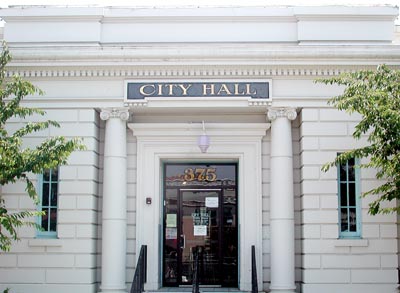By PATRICK DWIRE
DMB reports back to community on Rancho SB feedback
After nearly a year of a carefully orchestrated public relations
campaign conducted by DMB Associates for the master-planned
community proposed at the north end of the county, the developers
are checking to see if what they have heard from the community so
far is accurate.
DMB will be sending every resident in the county an overview of
a 15-page report summarizing the community input received in
several meetings, focus groups and direct mail questionnaires
hosted by the developer over the last 11 months.
By PATRICK DWIRE
DMB reports back to community on Rancho SB feedback
After nearly a year of a carefully orchestrated public relations campaign conducted by DMB Associates for the master-planned community proposed at the north end of the county, the developers are checking to see if what they have heard from the community so far is accurate.
DMB will be sending every resident in the county an overview of a 15-page report summarizing the community input received in several meetings, focus groups and direct mail questionnaires hosted by the developer over the last 11 months.
“We’ve made an honest attempt (in the report) to reflect what we have heard. Not what we wanted to hear,” said Ray Becker, spokesman for DMB. “We’re very anxious to know if we heard the community correctly.”
With the project not yet defined by DMB, the various transportation and infrastructure improvements necessary to support it are not clear. With no actual project plan to respond to, the community meetings were focused on broad issues such as improvements to transportation infrastructure, jobs and housing that are expected by the community as part of the project.
The report prepared by DMB summarizes the community input received to date, and prioritizes community concerns as follows: priority 1 – impacts on roads and traffic congestion, particularly on Highway 25; priority 2 – the potential positive impact the project should have on county’s economic vitality and job creation; and priority 3 – the need for more affordable housing.
Each of these issues are discussed in the report with “guiding principals” received from the community on how the developer should proceed in addressing them. DMB expects to unveil the actual project plan for El Rancho San Benito for the first time in mid-March. According to Becker, a formal project application to the county, including a development agreement detailing responsibilities and a development schedule, may be ready for consideration by November of next year. The earliest construction could actually get started is estimated to be 2010 or 2011.
“From my point of view, there’s nothing really the community can address at this point,” said Fred Goodrich, former assistant planning director for San Benito County, “because no plan has been put on the table. Not even a conceptual plan. Until we see what they are proposing, how can we respond?”
What participants have seen at the meetings is a map of the northern portion of the county with a huge, 4,500-acre parcel of land shaded as the project area owned by DMB. The northern boundary of the project area is bordered by Highway 25 with the northwest area bounded by the Pajaro River. The southern flank of the parcel abuts the Flint Hills. A narrow finger stretches to Highway 101 just north of the Betabel interchange.
The project area is just over 7 square miles, with roughly half the project area in a flood plain that DMB has indicated is likely to remain open space or in agricultural preserve. By way of comparison, the incorporated city limits of Hollister enclose about 6 square miles. The project site has four miles of frontage on Highway 25.
DMB has an impressive track record for planning whole communities, including commercial areas, schools and workplaces. The company typically secures all the necessary approvals for a detailed specific plan for an entirely new community, and then bids out the construction of the actual buildings to home and commercial builders. The company has developed a number of master-planned, mostly high-end communities, often with private golf clubs in gated communities, ranging in size from 11,000 homes in its Verrado community 25 miles west of Phoenix, Ariz., roughly about the size of the city of Hollister, to 1,500 home sites and community facilities, including a golf course, under development on the island of Kauai, Hawaii.
Secondary to concerns about transportation, county Planning Commissioner Dan De Vries has seen DMB’s communities via its website and is impressed with the quality of the work they have done, including “new urbanism” practices of mixing retail with residential in small town commercial centers. De Vries is concerned about what this could mean for downtown Hollister, especially considering the rising percentage of commuters from Hollister to Santa Clara Valley.
“In the future it might make more sense to stop and have dinner in an upscale restaurant at El Rancho San Benito on the way home from work rather having dinner in downtown Hollister,” De Vries said. “But it’s real hard to tell what impacts we should be concerned about without any indication what they are planning to develop.”
While DMB, Inc. has been careful not to reveal even an estimate of how many housing units may be proposed in the project, or how much commercial and industrial space, schools, community facilities, or open space is to be included in the plan, the message of the report is that the company has listened to the concerns of the community.
“With this report,” Becker said, “we’re very anxious to find out – did we hear you correctly?”
At the “transportation” community meeting conducted on Sept. 13 at the Veterans Memorial Building, the option of an additional, cross-county freeway, splitting off from Highway 25 and running through the project area to an interchange at U.S. 101 near the existing Betabel interchange appeared to be the most attractive option to DMB. While not expressing any preference for the various cross-county transportation options outlined in the recently released Southern Gateway Transportation and Land Use Study, Caltrans representative Greg Albright warned that state transportation funding is competitive, and the sooner the community reaches consensus on what it wants to see built, the better.
Becker later discussed the new road as a preferred option because the environmental clearances for the new freeway may be greatly expedited by not trying to cross the Pajaro River north of the Betabel Interchange to get to U.S. 101. This option would also avoid crossing county lines, and Caltrans District lines.
The new, cross-county freeway idea is similar to the “three-in-one” proposal made a few years ago by the San Benito Farm Bureau, proposed as an alternative to widening Highway 156 across San Juan Valley, which would require significant loss of prime farm land.
The report acknowledges there are very mixed feelings throughout the county about growth in general, stating that about “a quarter of the population of San Benito County is unswervingly anti-growth. No type of new development would be acceptable to them, under any circumstances.” The report recognizes this is not without reason, reporting that residents “are uniform in their belief that the development boom of the ’90s was not well planned or managed.” Even the newcomers who benefited from that growth, according to the report, acknowledge the impacts on the city and county infrastructure were poorly anticipated.
The summary of community input also acknowledges the 1 percent growth cap adopted by the county in 2000 continues to be supported by the majority of people surveyed, mostly for reasons related to traffic on already congested roads, loss of rural character, and further impacts on over-stretched public services. However, the report also states that “virtually everyone” believes growth is inevitable.
How much growth is inevitable, as proposed in El Rancho San Benito, is still a wide open question. What Becker has made clear is he fully expects the El Rancho San Benito project to go to a vote of county residents, as required by a county ordinance for projects greater than 100 units. That vote will either approve or deny the necessary adjustments to the county’s general plan to legally approve the project application. As part of the development agreement DMB hopes to reach with the county, the project would be exempted from the regular growth management allocation process, which allocates an average of only about 60 new units per year, well as the county’s 30 percent affordable housing requirement.
The county’s inclusionary housing ordinance requires 30 percent of newly developed units to be sold at prices that middle, and relatively low-income families can afford to buy. Developers typically oppose such stringent affordable housing requirements, and DMB is no exception. Becker said he thought the county’s inclusionary requirement is too rigid, and the project proposal would “probably not” adhere to requirements of the ordinance because it “won’t allow the flexibility” DMB wants to have in designing the project.
Instead, the project residents will vote on as well as the development agreement reached with the county will have its own “affordability package,” Becker said, which presumably will be less stringent in the price restrictions required by the county ordinance, but will possibly include fewer re-sale restrictions that come with the purchase of below-market rate homes pursuant to the county ordinance.
“We are looking to serve the needs of a broader range of folks than the existing ordinance allows,” Becker said. “We want to take an optimum approach to serving as many San Benito residents as possible.”
The affordability package under discussion by DMB, Inc. includes a diversity of housing types, including rental apartments, condominiums, small attached and detached units, as well as large, high-end executive estate homes. Financing mechanisms to assist working families in buying a home at El Rancho San Benito, such as “silent second mortgages” or equity sharing agreements are also under consideration.
The guiding principals for affordable housing as stated in DMB’s community input report include, “the construction of a certain number of rental and price-assisted units, local home-buyer assistance programs, and collaboration with other community housing entities that will achieve significant County housing objectives in the most effective manner.”
Below-market rate price restrictions in the existing inclusionary housing ordinance are geared for what moderate, low and very low income families can afford to borrow for a home mortgage based on incomes defined by 120 percent, 80 percent, and 50 percent of the county’s median income respectively. (See sidebar, “What is affordable?”)
At a community meeting on housing held on Oct. 25 conducted primarily in Spanish, District 5 Supervisor Jaime De La Cruz polled the audience on how many families had incomes greater than $40,000 per year, and De La Cruz estimated that less than 10 percent of those at the meeting raised their hands. The DMB report includes the comment, “A diverse supply of rental and for sale homes should be matched to local needs.”
At a presentation to the Board of Supervisors on Sept. 27, De La Cruz emphasized the need for jobs in San Benito County, while District 1 Supervisor Don Marcus emphasized the need for a comprehensive fiscal impact analysis of the project to ensure the county will ultimately be able to recover the costs of providing public services for new community. With the county only receiving back about 11 cents for every dollar paid in property taxes, Marcus said he would be “very sensitive” to the long term fiscal impacts of the project.
Copies of the report summarizing the community input received by DMB are available by calling DMB’s Hollister office at 635-5910, or at their office itself located at 615 San Benito Street, Suite #101. More information about DMB’s community outreach effort is available at www.elranchosanbenito.com.







